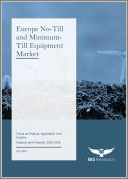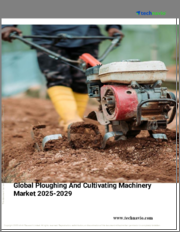
|
시장보고서
상품코드
1524068
유럽의 무경운 및 최소 경운 장비 시장 : 제품별, 용도별, 국가별 - 분석과 예측(2023-2028년)Europe No-Till and Minimum-Till Equipment Market: Focus on Product, Application, and Country - Analysis and Forecast, 2023-2028 |
||||||
유럽의 무경운 및 최소 경운 장비 시장 규모(영국 제외)는 2023년에 13억 3,930만 달러에 달했습니다.
이 시장은 2038년에는 17억 5,350만 달러에 달할 것으로 예측되며, 예측 기간인 2023-2028년 CAGR은 5.54%에 달할 전망입니다. 무경운 및 최소 경운 장비 시장은 세계 농업계의 지속적인 기술 발전으로 인해 예측 기간 중 빠르게 성장할 것으로 예상됩니다. 피복 작물 전략은 토양의 건전성과 비옥도를 개선하여 무경운 및 최소 경운 장비 분야의 성장을 가속화할 것입니다. 농가는 침식을 줄이고, 잡초를 방제하고, 유기물을 개선하기 위해 피복 작물을 사용합니다.
| 주요 시장 통계 | |
|---|---|
| 예측 기간 | 2023-2028년 |
| 2023년 평가 | 13억 3,930만 달러 |
| 2028년 예측 | 17억 5,350만 달러 |
| CAGR | 5.54% |
유럽의 무경운 및 최소 경운 장비 시장은 지속가능한 농법에 대한 인식이 높아지고 토양 건강성을 개선해야 한다는 필요성에 따라 빠르게 성장하고 있습니다. 무경운 및 최소 경운 농법은 토양 교란을 줄이고, 수분 보유력을 높이며, 탄소 고정을 증가시킵니다. 이러한 농법은 유럽의 농가가 엄격한 환경 규제를 충족하고 환경 친화적인 농업 기술을 도입하기 위해 노력하고 있으므로 인기를 끌고 있습니다.
독일, 프랑스, 영국 등 주요 국가들은 지속가능한 농업을 촉진하기 위한 정부의 장려책과 연구 구상에 힘입어 무경운 및 최소 경운 장비의 사용을 선도적으로 추진하고 있습니다. 이 시장 특징은 토양을 건강하게 유지하면서 작물 수확량을 극대화하는 것을 목표로 하는 파종 및 파종기계의 기술 발전입니다.
지속가능한 농업 솔루션에 대한 수요가 증가함에 따라 유럽의 무경운 및 최소 경운 장비 시장은 더욱 확대될 것이며, 이는 환경과 농업 생산성에 큰 이점을 가져다 줄 것입니다.
유럽의 무경운 및 최소 경운 장비 시장에 대해 조사했으며, 시장의 개요와 제품별, 용도별, 국가별 동향 및 시장에 참여하는 기업의 개요 등을 제공하고 있습니다.
목차
조사 범위
개요
제1장 시장
- 업계 전망
- 비지니스 역학
- 자금조달과 투자의 상황
제2장 지역
- 유럽
- 영국
제3장 시장 - 경쟁 벤치마킹과 기업 개요
- 경쟁 벤치마킹
- 경쟁 포지션 매트릭스
- 시장 점유율 분석
- 기업 개요
- Vaderstad Group
- Salford Group Inc.
- CNH Industrial N.V.
제4장 조사 방법
KSA 24.08.06Introduction to Europe No-Till and Minimum-Till Equipment Market
The Europe no-till and minimum-till equipment market (excluding U.K.) was valued at $1,339.3 million in 2023 and is expected to reach $1,753.5 million by 2038, growing at a CAGR of 5.54% during the forecast period 2023-2028. The market for no-till and minimum-till equipment is expected to expand rapidly over the forecast period as a result of ongoing technological advancements in the global agricultural industry. Cover cropping strategies accelerate growth in the no-till and minimum-till equipment sectors by improving soil health and fertility. Farmers use cover crops to reduce erosion, control weeds, and improve organic matter.
| KEY MARKET STATISTICS | |
|---|---|
| Forecast Period | 2023 - 2028 |
| 2023 Evaluation | $1,339.3 Million |
| 2028 Forecast | $1,753.5 Million |
| CAGR | 5.54% |
Market Introduction
The European no-till and minimum-till equipment market is expanding rapidly, driven by growing awareness of sustainable agricultural practices and the need to improve soil health. No-till and minimum-till farming methods reduce soil disturbance, improve water retention, and increase carbon sequestration. These practices are gaining popularity as European farmers strive to meet stringent environmental regulations and implement more environmentally friendly farming techniques.
Key countries such as Germany, France, and the United Kingdom are pioneering the use of no-till and minimum-till equipment, aided by government incentives and research initiatives aimed at promoting sustainable agriculture. The market is characterized by technological advancements in seeding and planting machinery, which are intended to maximize crop yields while maintaining soil integrity.
As the demand for sustainable farming solutions grows, Europe's no-till and minimum-till equipment markets are set to expand further, providing significant environmental and agricultural productivity benefits.
Market Segmentation
Segmentation 1: by Application
- Farms and Agricultural Fields
- Orchards and Vineyards
- Pastures and Grazing Lands
- Nurseries and Urban Agriculture
- Others
Segmentation 2: by Product
- Seed Drills and Planters
- Cover Crop Seeders
- Cultivators and Tillage Equipment
- Precision Agriculture Technologies
- Others
Segmentation 3: by Region
- Europe - Germany, France, Netherlands, Italy, Belgium, Ukraine, Switzerland, Greece, and Rest-of-Europe
- U.K.
How can this report add value to an organization?
Product/Innovation Strategy: In the dynamic landscape of the no-till and minimum-till equipment market, significant advancements are revolutionizing agricultural practices, with a dedicated focus on optimizing farm performance. Harnessing cutting-edge solutions, including AI-driven analytics and real-time monitoring platforms, no-till and minimum-till equipment provide detailed insights into soil health, crop management, and resource utilization. Innovations such as precision agriculture techniques contribute to efficient farming practices, ensuring optimal crop yield and environmental sustainability. The market encompasses a diverse range of solutions, from state-of-the-art planting equipment to precision seeding systems, empowering farmers to enhance operational efficiency and minimize resource utilization effectively.
Growth/Marketing Strategy: The Europe no-till and minimum-till equipment market is undergoing a remarkable transformation, mirroring the growth strategies observed in the server GPU sector. Key players in the industry are strategically expanding their business horizons, fostering collaborations, and entering partnerships to fortify their global presence. This trend aligns with the shift toward climate-smart agriculture, where companies are not only focused on technological advancements but also on sustainable farming practices. The synergy between technology firms and agricultural experts is driving the development of cutting-edge, climate-smart monitoring tools. Joint ventures and collaborative initiatives are instrumental in integrating diverse expertise, ultimately enhancing the market presence of these climate-smart solutions. This collaborative approach is pivotal in creating comprehensive, user-friendly, and efficient solutions for the evolving landscape of no-till and minimum-till agriculture.
Competitive Strategy: In the ever-evolving landscape of the Europe no-till and minimum-till equipment market, manufacturers are diversifying their product offerings to address a wide range of agricultural needs and practices. Comprehensive competitive analysis underscores the specific capabilities of market participants, showcasing their tailored solutions and specialized knowledge in different regions. Collaborations with agricultural research institutions and technology organizations play a crucial role in fostering innovation and steering the continual transformation of the no-till and minimum-till equipment sector.
Table of Contents
Scope of the Study
Executive Summary
1 Markets
- 1.1 Industry Outlook
- 1.1.1 Ongoing Trends
- 1.1.1.1 Expansion of Cover Cropping Techniques for Soil Health Enhancement
- 1.1.1.2 Integration of Digital Farming Platforms for Data-Driven Decision-Making
- 1.1.1.3 Emerging Automation in No-Till and Minimum-Till Equipment
- 1.1.2 Ecosystem/Ongoing Programs
- 1.1.2.1 Consortiums and Associations
- 1.1.2.2 Government Initiatives and their Impacts
- 1.1.1 Ongoing Trends
- 1.2 Business Dynamics
- 1.2.1 Business Drivers
- 1.2.1.1 Environmental Sustainability and Soil Health
- 1.2.1.2 Water Conservation and Efficiency
- 1.2.1.3 Reduced Chemical Usage and Pesticide Management
- 1.2.1.4 Governmental Support and Policy Initiatives
- 1.2.2 Business Challenges
- 1.2.2.1 Initial Capital Investments
- 1.2.2.2 Supply Chain Disruptions in the No-Till and Minimum-Till Equipment Market
- 1.2.2.3 Knowledge and Skill Gap
- 1.2.3 Market Strategies and Developments
- 1.2.3.1 Business Strategies
- 1.2.3.1.1 Product Development and Innovations
- 1.2.3.1.2 Market Development
- 1.2.3.2 Corporate Strategies
- 1.2.3.2.1 Mergers and Acquisitions
- 1.2.3.2.2 Partnerships, Collaborations, Joint Ventures, and Alliances
- 1.2.3.2.3 Others
- 1.2.3.1 Business Strategies
- 1.2.4 Business Opportunities
- 1.2.4.1 Advanced No-Till and Minimum-Till Equipment Technology
- 1.2.4.2 Eco-Friendly Farming Input Supply Chain
- 1.2.5 Case Studies
- 1.2.1 Business Drivers
- 1.3 Funding and Investment Landscape
- 1.3.1 Funding Analysis (by Year)
- 1.3.2 Funding Analysis (by Company)
- 1.3.3 Funding Analysis (by Country)
2 Regions
- 2.1 Europe
- 2.1.1 Europe (by Country)
- 2.1.1.1 Italy
- 2.1.1.2 France
- 2.1.1.3 Germany
- 2.1.1.4 Netherland
- 2.1.1.5 Belgium
- 2.1.1.6 Switzerland
- 2.1.1.7 Greece
- 2.1.1.8 Ukraine
- 2.1.1.9 Rest-of-Europe
- 2.1.1 Europe (by Country)
- 2.2 U. K.
3 Markets - Competitive Benchmarking & Company Profiles
- 3.1 Competitive Benchmarking
- 3.1.1 Competitive Position Matrix
- 3.1.2 Market Share Analysis
- 3.2 Company Profiles
- 3.2.1 Vaderstad Group
- 3.2.1.1 Company Overview
- 3.2.1.2 Product and Customer Portfolio Analysis
- 3.2.2 Salford Group Inc. (part of Linamar Corporation)
- 3.2.2.1 Company Overview
- 3.2.2.2 Product and Customer Portfolio Analysis
- 3.2.3 CNH Industrial N.V.
- 3.2.3.1 Company Overview
- 3.2.3.2 Product and Customer Portfolio Analysis
- 3.2.1 Vaderstad Group
4 Research Methodology
- 4.1 Data Sources
- 4.1.1 Primary Data Sources
- 4.1.2 Secondary Data Sources
- 4.2 Market Estimation and Forecast
- 4.2.1 Factors for Data Prediction and Modeling



















